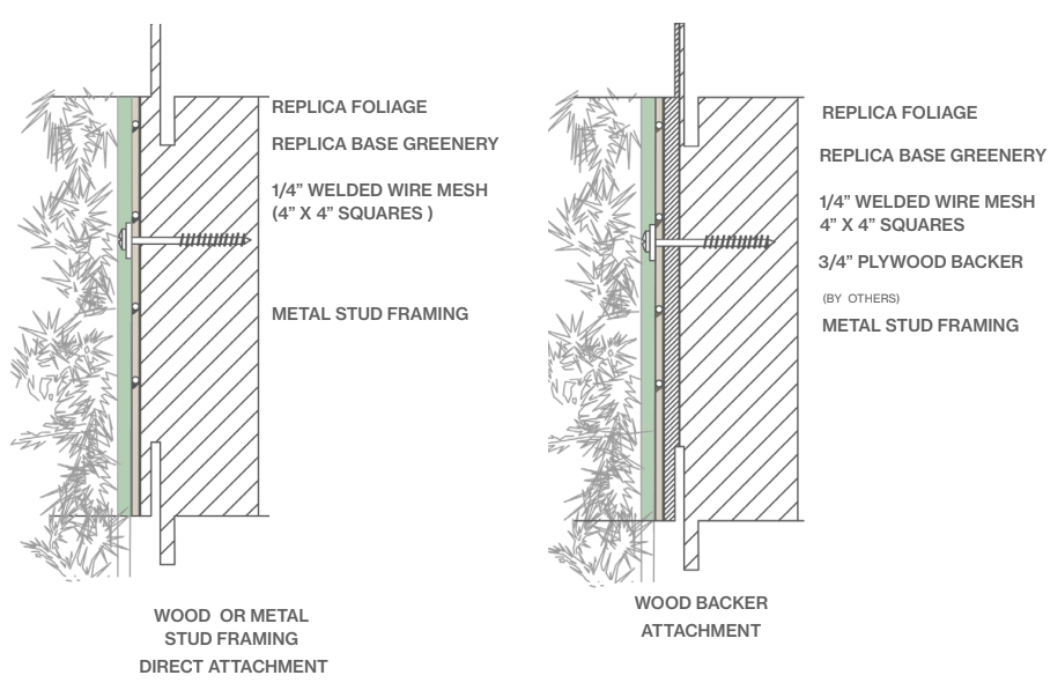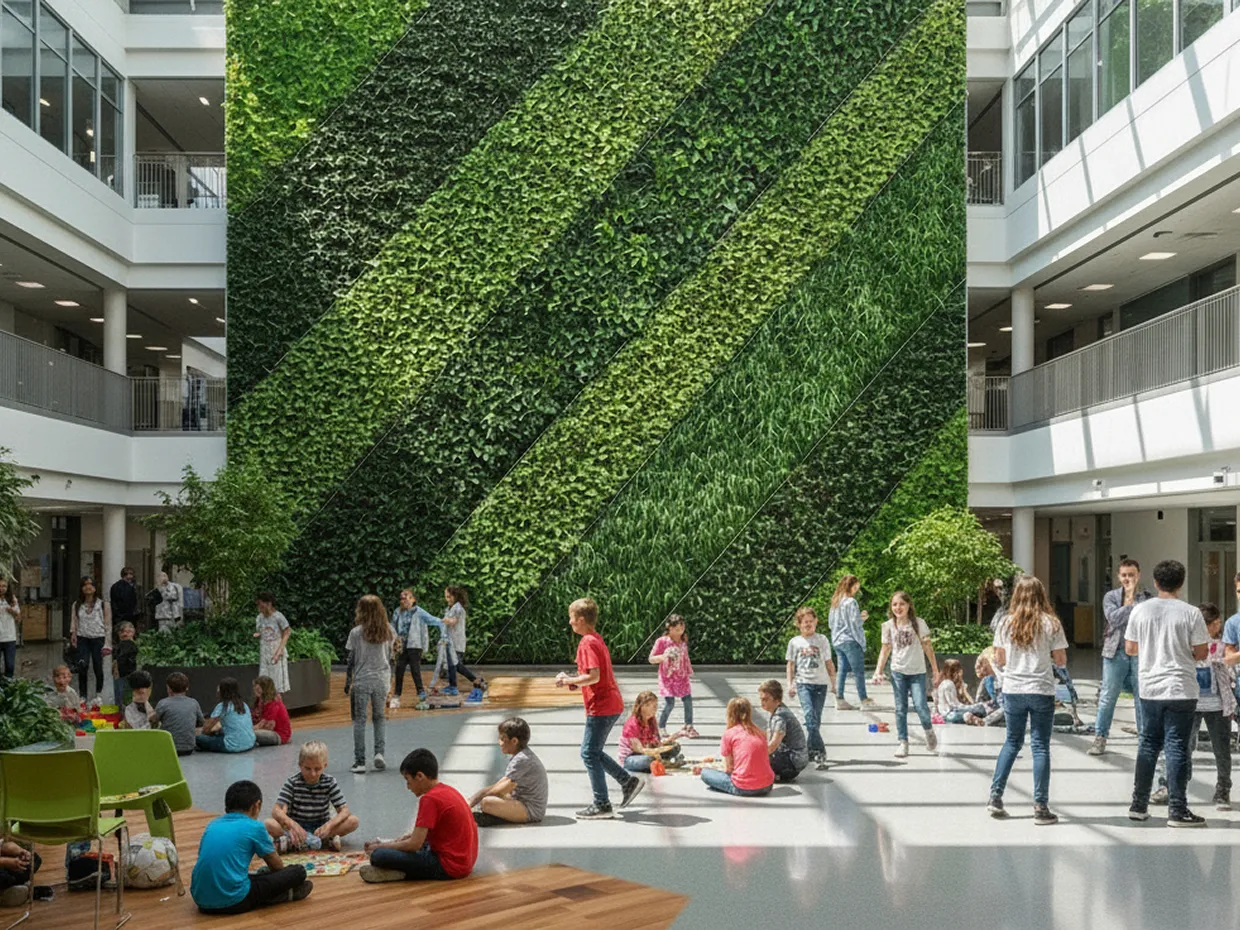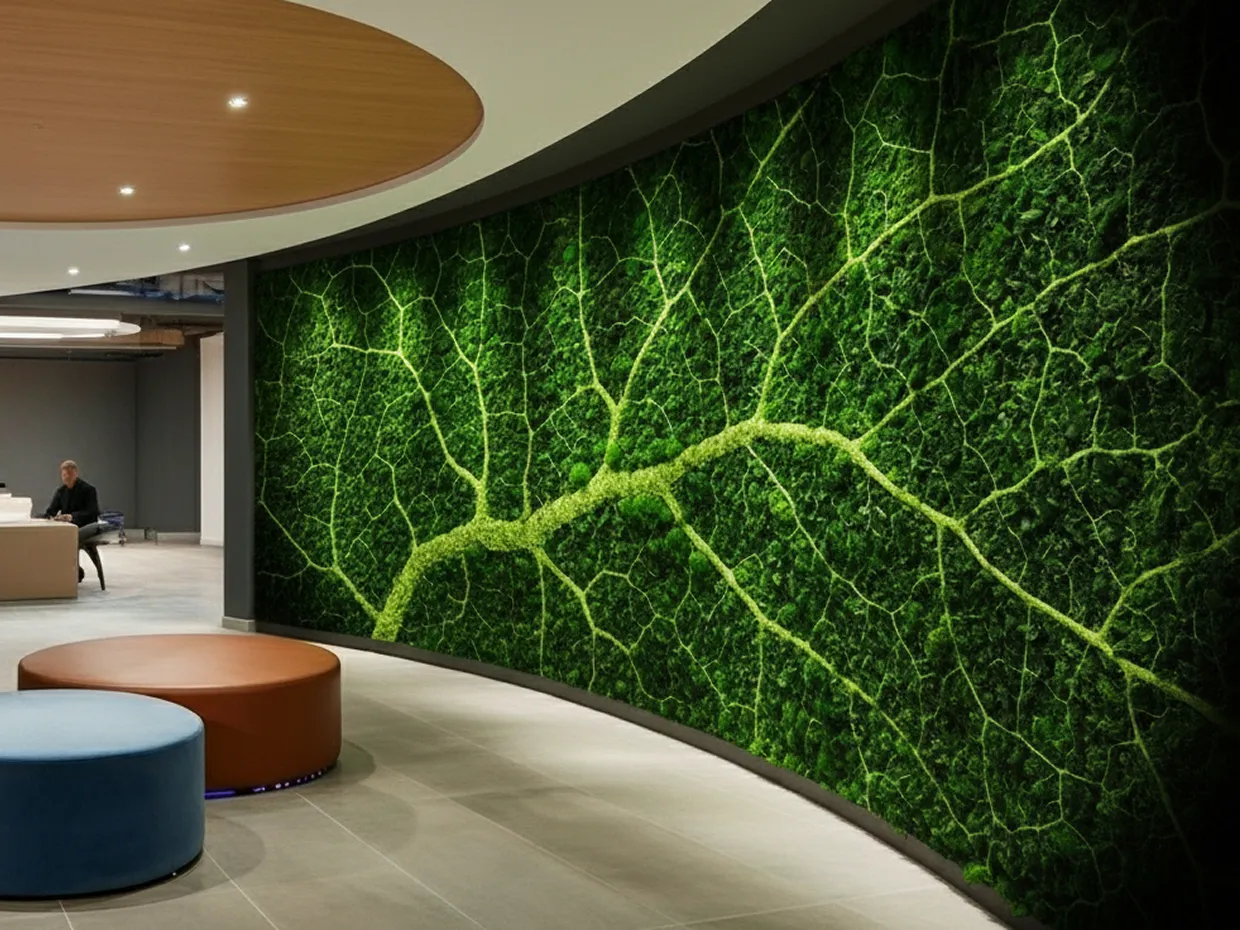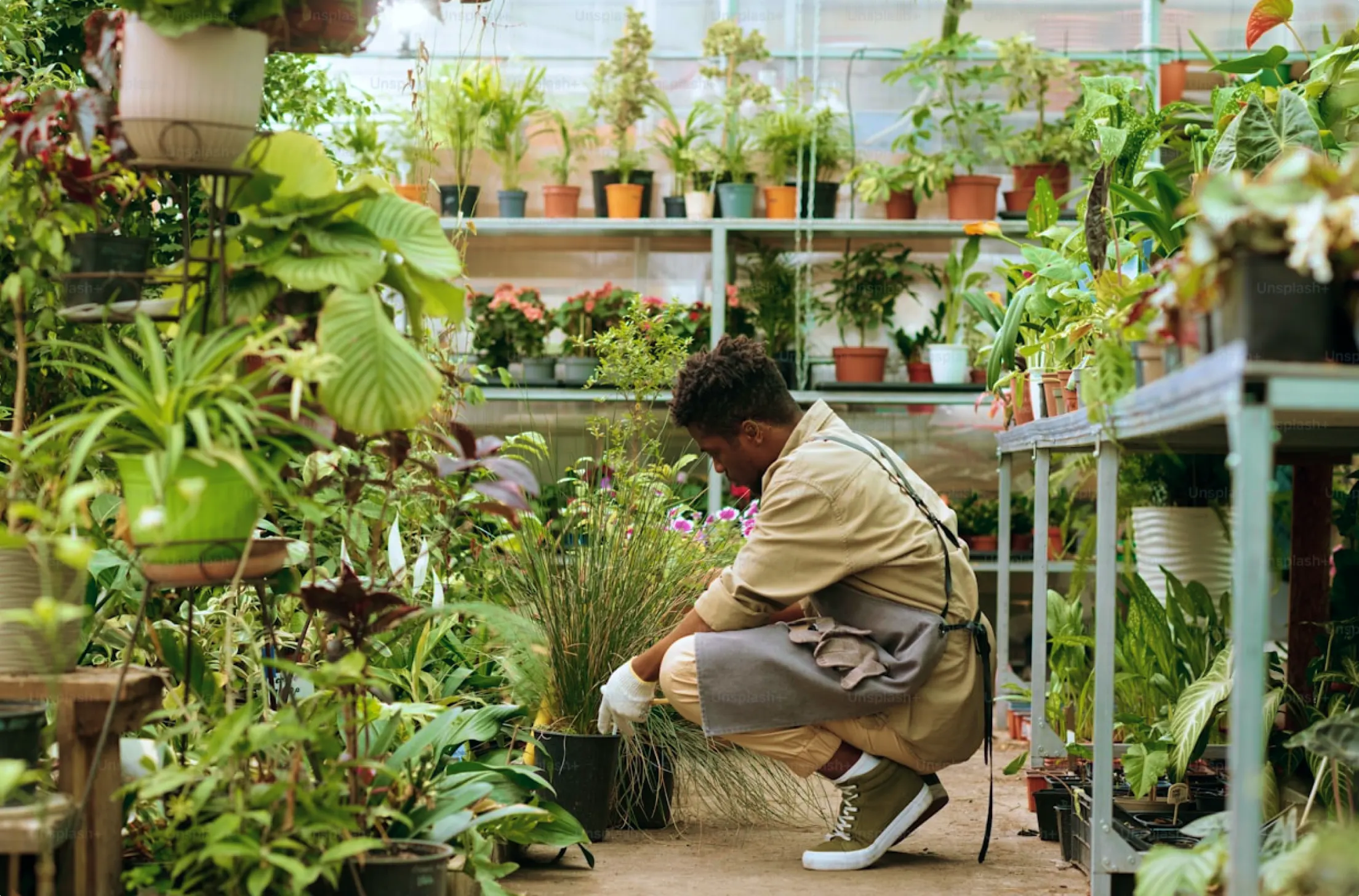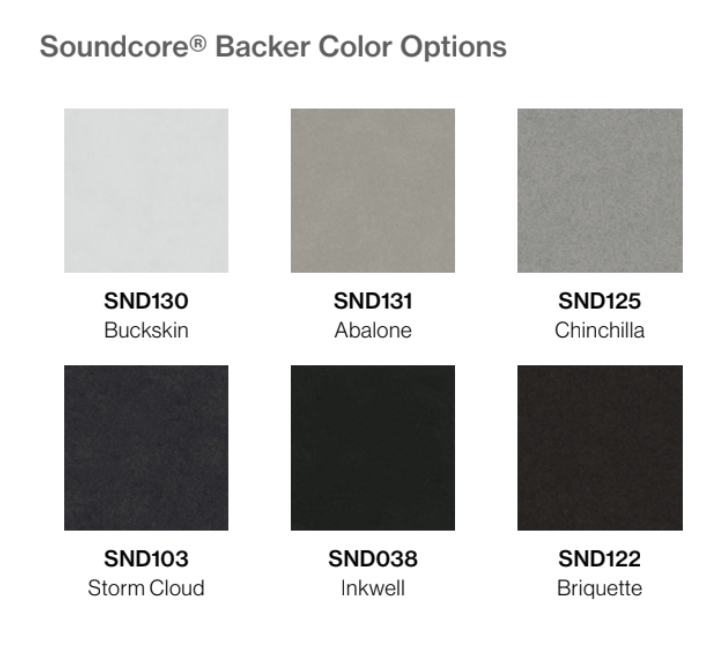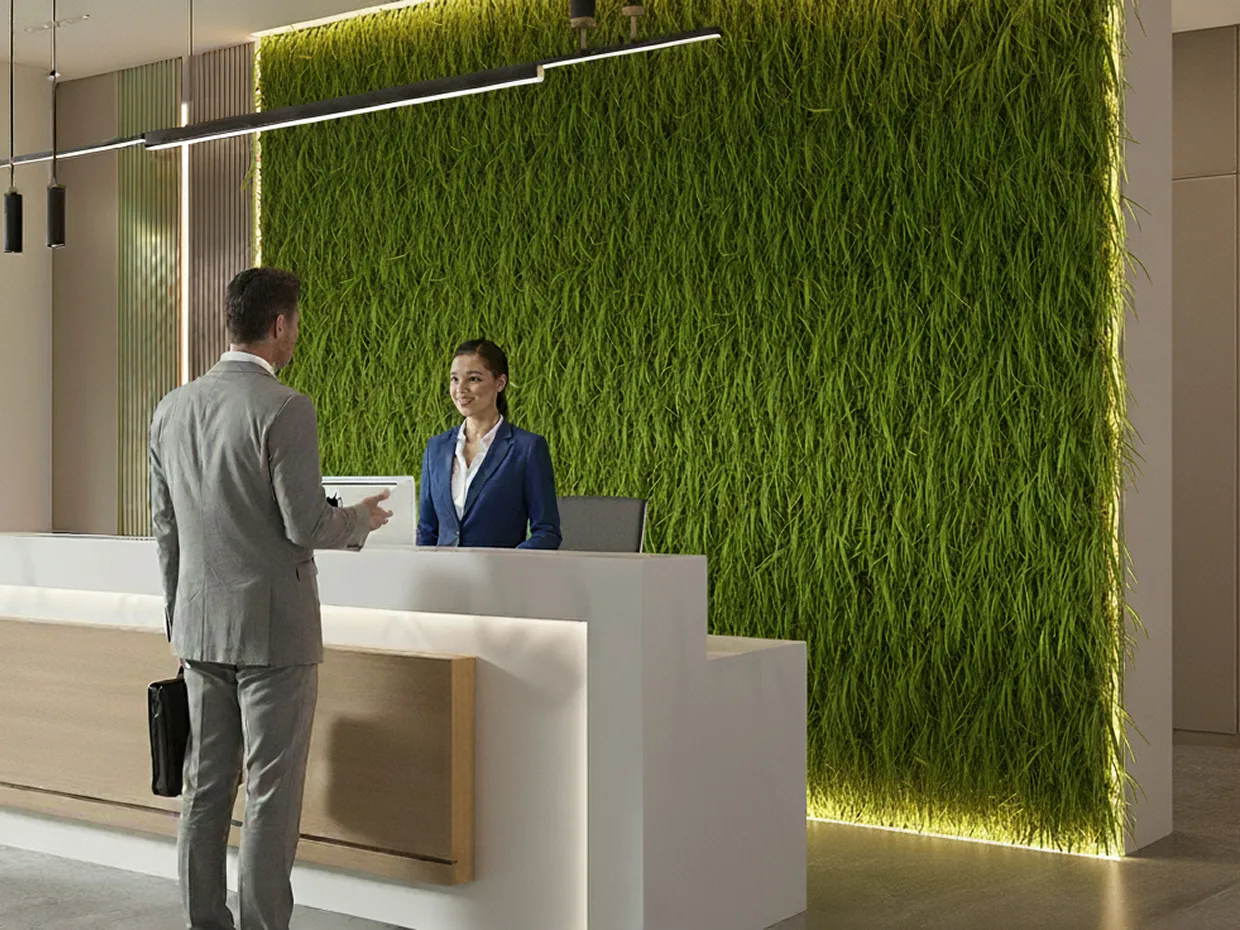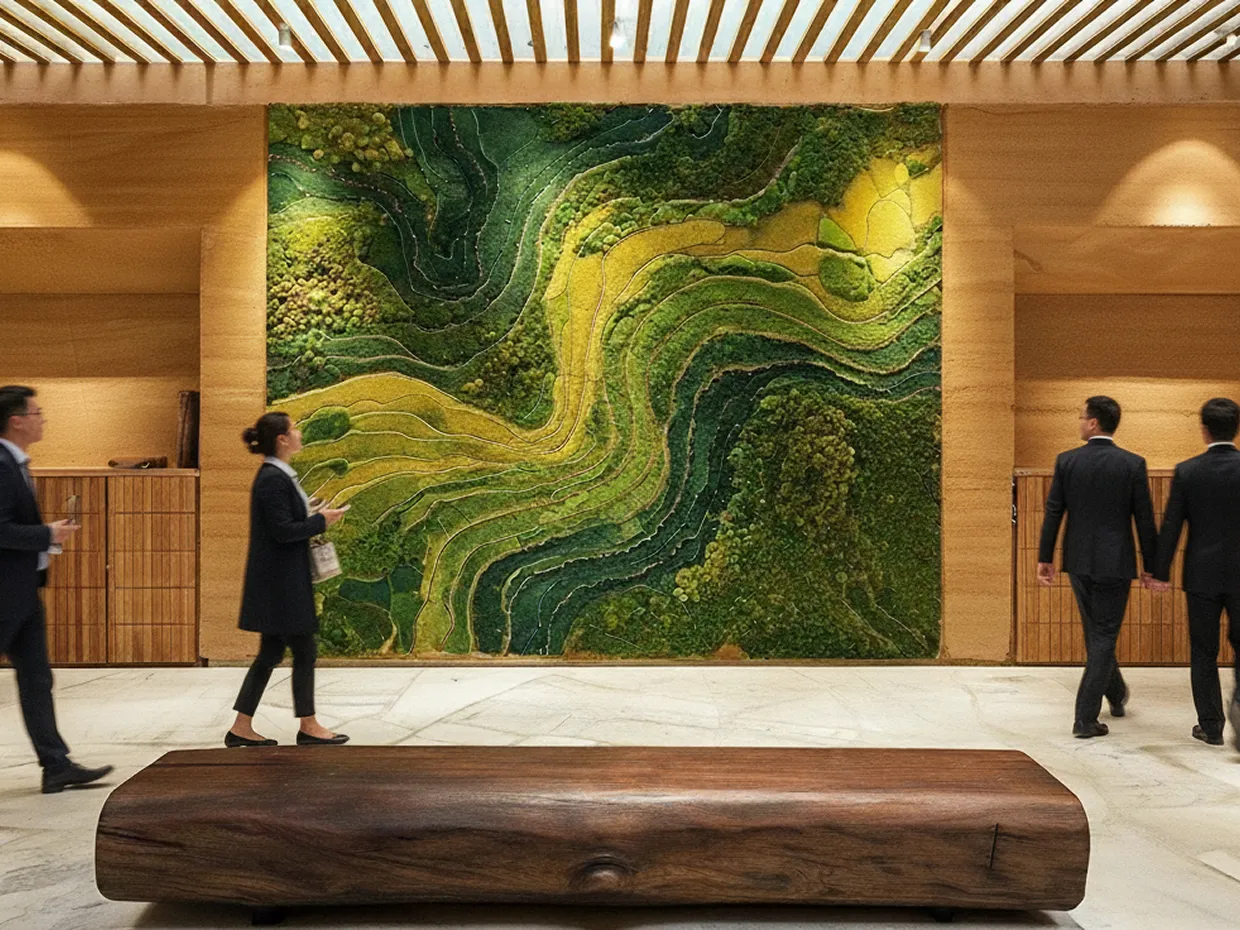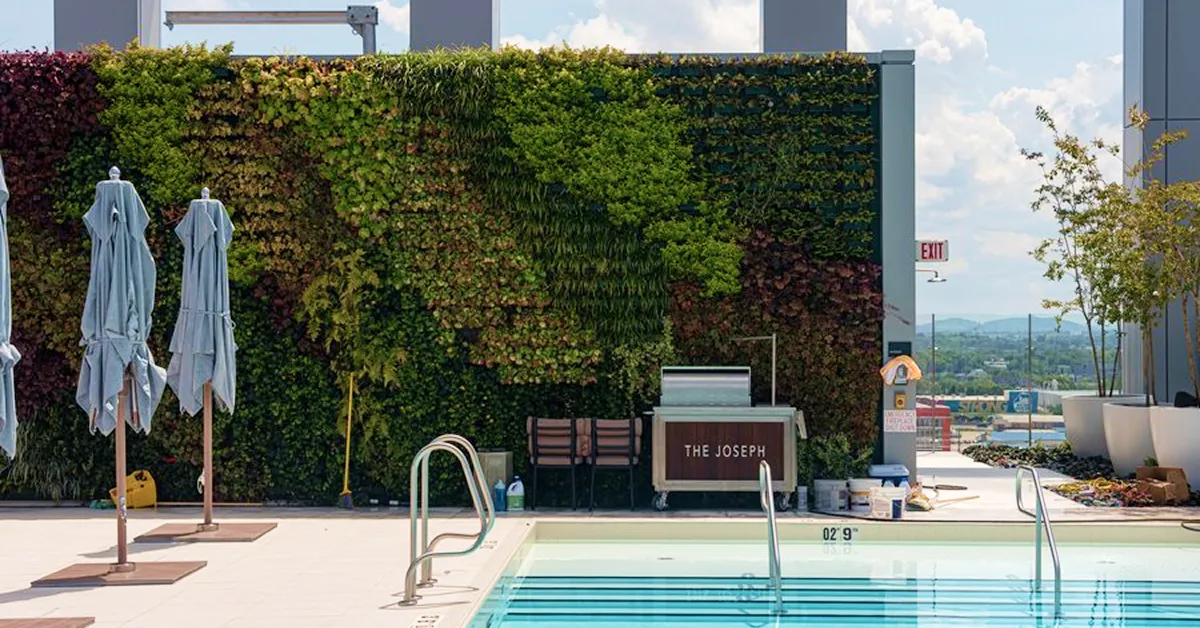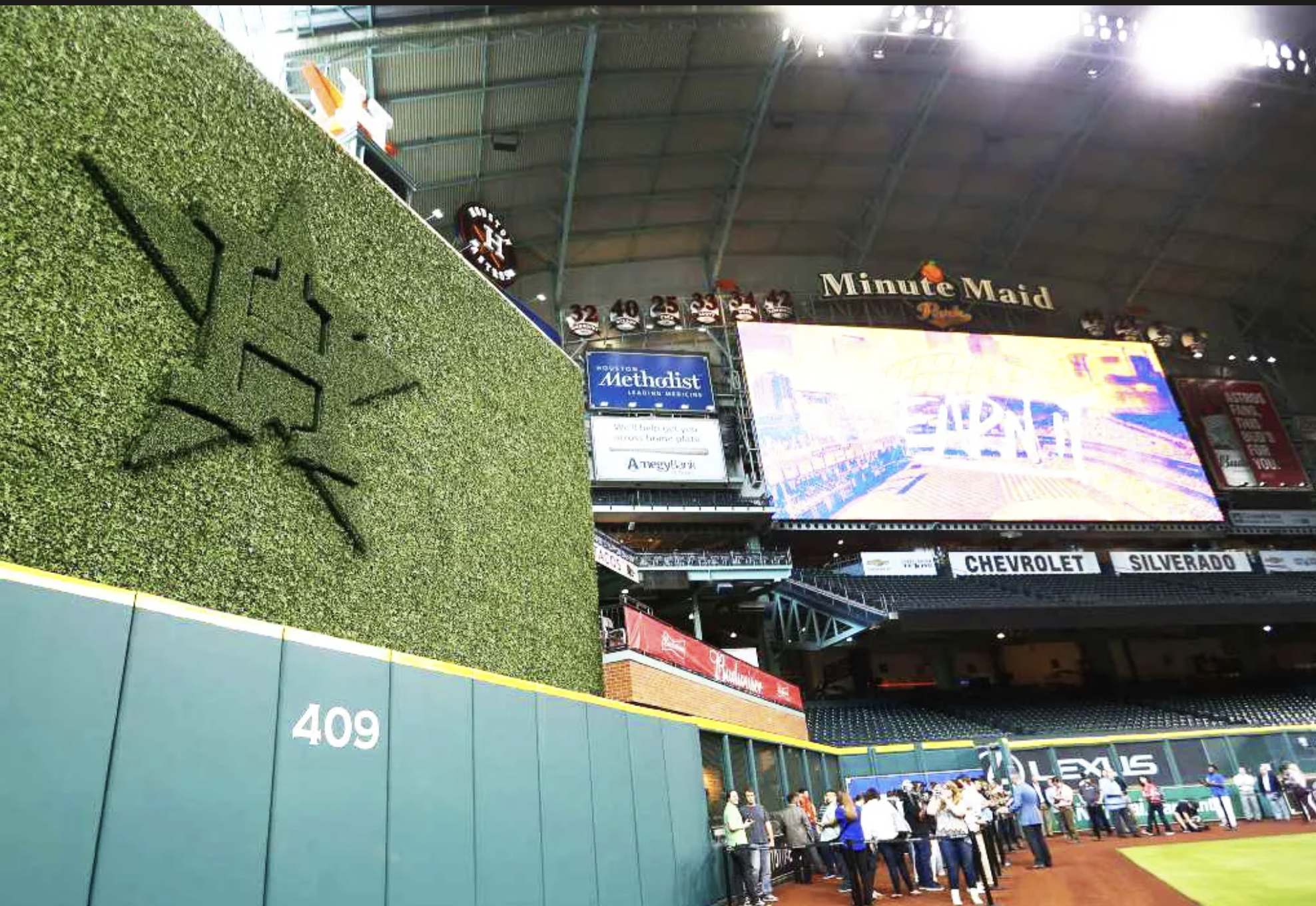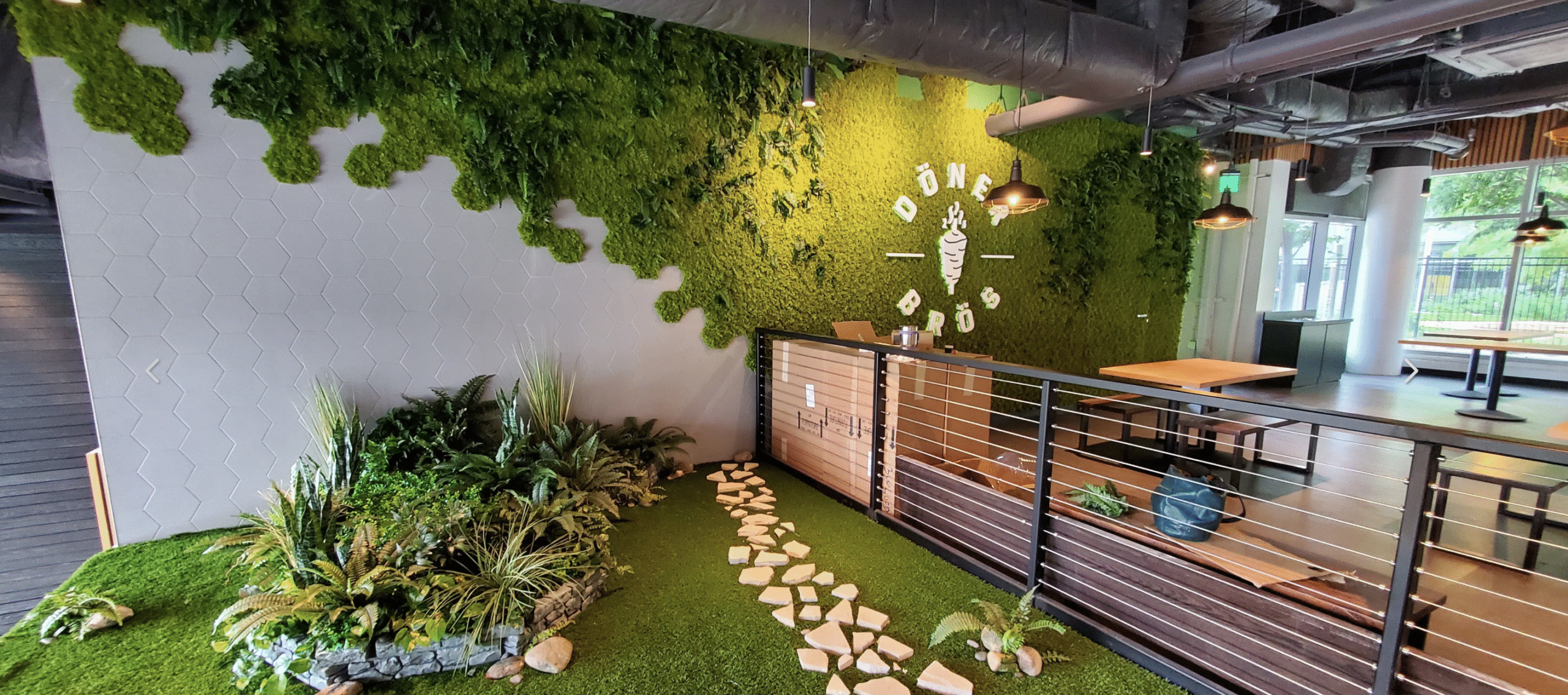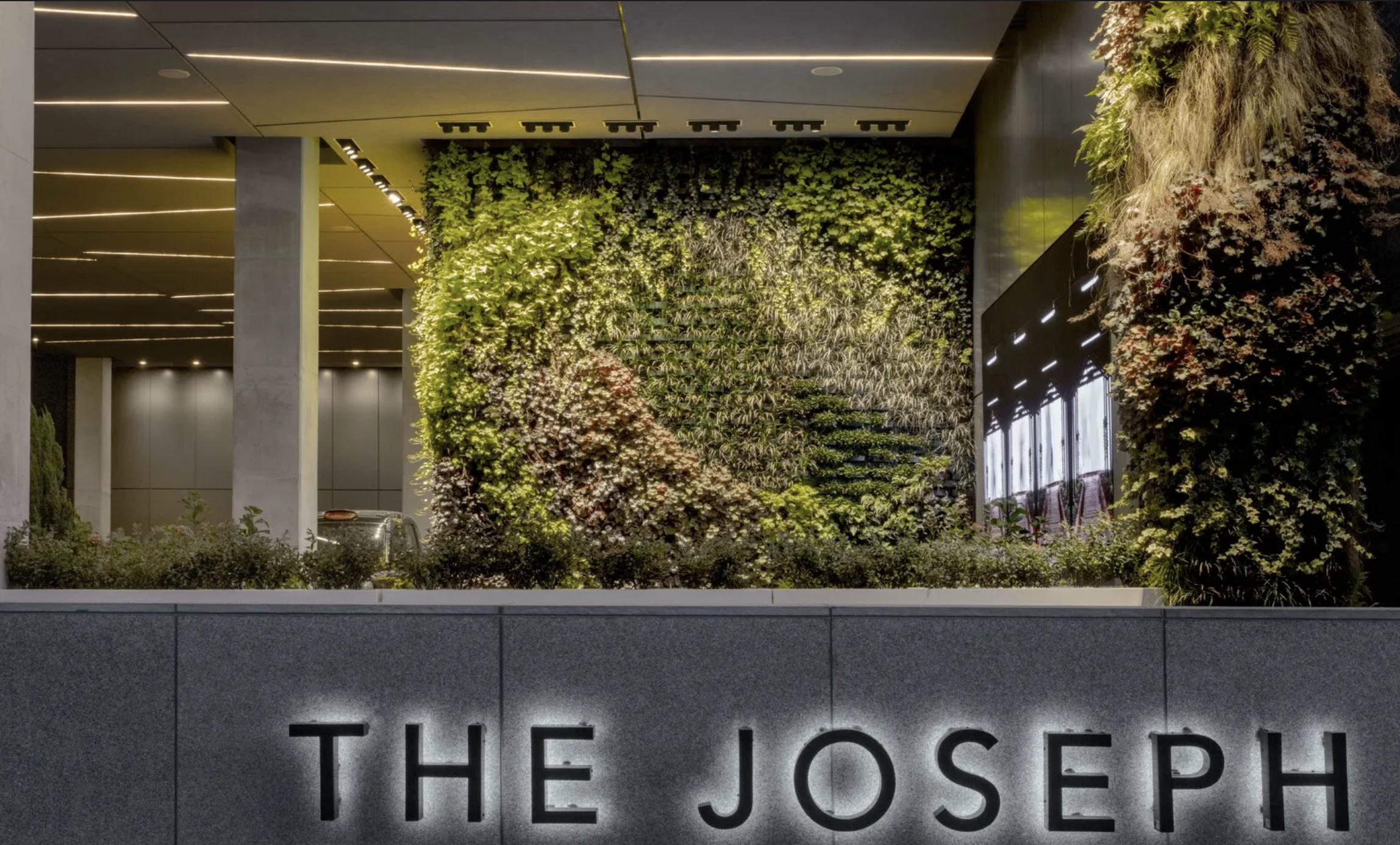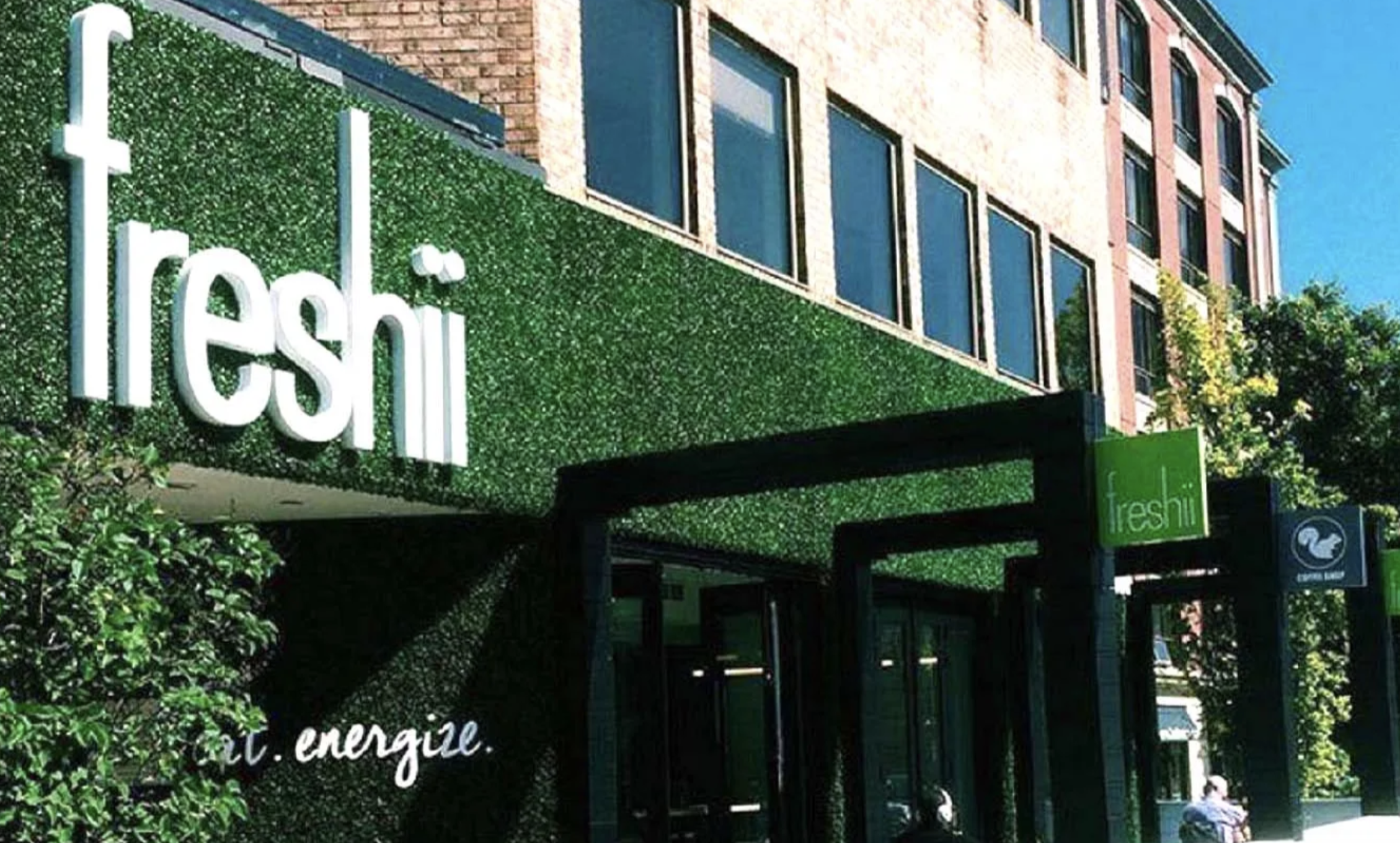
Introduction to Green Walls in Modern Architecture
Green walls — also known as living walls or vertical gardens — are architectural systems where plants are grown vertically along a structural surface, often using integrated hydroponic, preserved, or artificial foliage systems. Green walls are engineered solutions that include mounting panels, irrigation systems, and substrates to support plant life or realistic botanical facades. These systems can be installed both indoors and outdoors, enhancing environmental performance while introducing a natural, dynamic texture to architectural surfaces.
Green walls are essential in biophilic and sustainable design, functioning as more than decorative features. Green walls absorb sound in even high-traffic commercial spaces, improve indoor air quality (depending on the green wall’s foliage material), and reduce thermal loads (also depending on the foliage material), all while reinforcing brand identity through natural color, texture, and movement. Their aesthetic and sensory impact contributes to wellness-oriented design — bringing the restorative effects of nature indoors.
Architects and designers can use these systems to create immersive environments where form and sustainability coexist. Whether replica, preserved, or living, every green wall design begins with a technical understanding of its structure and compatibility with the surrounding architectural system, ensuring that the result is both visually inspiring and functionally integrated.
How Green Walls Attachment Systems Work & Their Structural Integrity
The success of a green wall depends heavily on how it attaches to architectural surfaces. A well-engineered attachment system ensures structural safety, design longevity, and acoustics improvements while also influencing installation speed and long-term maintenance. Today’s green walls are typically installed through one of four core systems: direct-mount, grid-frame, freestanding, or suspended configurations.
| Attachment Method | Technical Description | Recommended Application | Design Outcome |
| Direct-Mount Panels | Modular panels fixed directly to the wall substrate. | Interiors using preserved greenery due to its weight. | Slim profile and minimal surface disruption. |
| Grid or Rail Systems | Metal or composite framing supports modular greenery trays. | Exterior or living green walls requiring irrigation and access. | Easy access to greenery’s backer and irrigation system. |
| Freestanding Systems | Independent structural assemblies with internal support frames and weighted bases. | Greenery acting as privacy screens or as room dividers. | Mobile, and spatially defining. |
| Suspended Systems | Greenery panels or baffles hung from ceiling grids. | Replica or lightweight greenery in general. | Floating visual layers and light diffusion. |
Freestanding systems gained momentum in post-pandemic workspace design, where flexibility and adaptability are key. These independent walls not only divide space but also improve acoustics and wellness perception without adding permanent boundaries.
Direct-mounted preserved or replica greenery systems, on the other hand, are ideal for tight wall depths, offering instant installation and low maintenance. Living wall systems, especially grid-based ones, demand deeper analysis of load-bearing walls, irrigation access, and plant survival conditions. Each attachment type introduces a different rhythm to the overall architectural composition — and mastering this structural foundation sets the stage for success in later design and material decisions.
Ways & Options to Customize Green Walls Systems
Designing a green wall involves orchestrating multiple material and aesthetic decisions that determine its overall tone and longevity. From texture to color, from greenery density to the backer material, every component affects the visual depth, maintenance needs, and environmental performance of the installation; things we are going to go through in detail.
1. Green Walls Customization: Texture and Material Selection
The texture of a green wall sets the mood of a space. Architects can manipulate this through the selection of foliage type and density:
-
Replica Greenery: Made from high-grade synthetics, replica foliage maintains a lush, consistent appearance over time. It requires no light, irrigation, or pruning, making it ideal for interiors with limited environmental control.
CSI Creative’s Green Walls, “Geometric”
-
Preserved Greenery: Real plants treated to maintain flexibility and color without ongoing care. Preserved mosses, ferns, and foliage bring authentic organic texture with reduced maintenance compared to living systems.
CSI Creative’s Preserved Moss Green Walls, Catenaria
-
Live Greenery: Selected for projects seeking the environmental and sensory benefits of living plants. They purify air and bring microclimatic regulation but require integrated irrigation and drainage systems.
Custom Living Green Walls Page Banner, CSI Creative
The greenery material directly dictates both the wall’s maintenance cycle and installation method. For instance, replica systems can be specified in lightweight PET or acoustic felt backers, while living systems often require hydroponic modules or soil substrate panels.
2. Green Walls Customization: Backer Materials and Structural Layers
The backer is the unseen but essential foundation of every green wall — the structural layer that supports and anchors the greenery system. Functionally, it serves as the mounting surface that holds the foliage panels, planting modules, or preserved greenery in place. Depending on the project type, a backer can be made of materials such as aluminum, PVC, marine-grade plywood, or acoustic felt, each selected based on the wall’s load requirements, environmental exposure, and acoustic or decorative intent.
Far from being a simple substrate, the backer determines the overall depth, rigidity, and compatibility of the system with the architectural surface. It also influences how the wall integrates with other building systems — such as irrigation lines, lighting, or acoustic treatments — ensuring stability, long-term durability, and seamless visual alignment. In short, the backer is what transforms a collection of plants or panels into a fully engineered, high-performance green wall system. Here are some of the mostly used backer materials when it comes to building green walls systems:
| Backer Type | Material Options | Thickness Range | Application Context |
|---|---|---|---|
| Acoustic PET Panels | Made from recycled PET felt with high NRC value. | 6–12 mm | Ideal for replica or preserved greenery; combines acoustics with biophilia. |
| Marine-Grade Plywood | Water-resistant engineered wood. | 15–25 mm | Common in living wall installations requiring moisture tolerance. |
| Composite Polymer Panels | Lightweight and corrosion-resistant. | 8–16 mm | Used for exterior facades and wet environments. |
The green wall’s backer color also plays a role — darker backers such as charcoal or forest tones visually enhance greenery depth, while lighter shades brighten interiors. The choice between felt, polymer, or plywood backers also determines the weight load and mounting technique.
CSI Creative’s Green Walls Backer Color Options in PET Felt
3. Green Walls Customization: Greenery Patterns, Color, and Arrangement Strategy
Pattern is where architectural intent meets biophilic artistry. A green wall can act as a visual anchor or a dynamic environmental backdrop depending on how greenery is arranged.
-
Uniform Coverage: A consistent plant texture, used for wellness-focused workspaces and healthcare facilities where visual calm is a priority.
-
Gradient Blends: Transitioning from darker to lighter foliage, or from dense ivy to fine moss, mimics natural light diffusion.
Illustration of Gradient Blends, Collage, Preserved Moss Green Wall Design by CSI Creative
-
Mosaic or Striated Layouts: Interlocking patterns or linear planting rows allow branding integration, color coding, or thematic expression (e.g., tropical stripes for hospitality).
-
Thematic Layering: Incorporating leaf shapes, flower accents, or color contrast — such as variegated philodendrons against matte moss — introduces focal points that guide the eye like architectural ornamentation.
Add-value elements like signage, three-dimensional lettering, or wayfinding graphics can be woven seamlessly into the design, using contrasting greenery density or negative space to form letters and logos directly within the wall’s plane.
Lighting also plays a critical role: grazing light enhances textural shadows, while integrated backlighting behind preserved panels creates ambient glow suitable for corporate lobbies and wellness centers.
Green Walls Form Factors: Scale, Modularity, and Volumetric Components
The physical composition of a green wall depends on its modular logic — how each section connects, repeats, or varies to form the larger architectural statement.
| Component Type | Description | Ideal Application |
|---|---|---|
| Tiles | Small square or rectangular modules (300–600 mm). Allow replacement flexibility and color variation. | Boutique interiors, signage backgrounds, or accent areas. |
| Panels | Pre-assembled units up to 4′ × 8′, fastened to frames or backer grids. | Large-scale feature walls or commercial facades. |
| Rolls/Sheets | Flexible greenery mats mounted with adhesives or mechanical clips. | Organic forms and continuous preserved moss surfaces. |
| Hedges and Freestanding Units | Modular cubic or linear greenery volumes, often on casters or weighted bases. | Spatial dividers in offices, corridors, or open-plan hospitality zones. |
When planning large-scale compositions, modularity should follow architectural rhythm — aligning panel seams with structural bays, lighting grids, or fenestration lines. This maintains order while allowing for sectional replacement if needed.
The Joseph, CSI Creative Custom Green Walls Use Case
Maintenance Logic and System Durability
| System Type | Water System | Maintenance Frequency | Expected Longevity | Notes |
|---|---|---|---|---|
| Replica | None | Dusting quarterly | 10–12 years | UV-resistant coating recommended for exterior conditions. |
| Preserved | None | Bi-annual humidity check | 5–8 years | Sensitive to direct sunlight; ideal for controlled interiors. |
| Living (Modular Hydroponic) | Integrated drip or mist irrigation | Monthly system check | Continuous | Highest survival rate (>90%) due to consistent hydration. |
| Living (Non-Modular Soil-Based) | Manual or basic drip irrigation | Weekly plant care | Variable | Survival rate 60–75%; dependent on substrate and drainage. |
According to Architizer’s design analysis, well-calibrated irrigation and substrate systems drastically improve the plant survival rate. Modular hydroponic panels allow precise control of water distribution and root aeration, while non-modular or improvised soil systems often face uneven hydration and root decay.
Architects must also account for maintenance access — concealed irrigation trays should include removable inspection covers, and freestanding hedge systems should feature accessible service hatches for water refill and cleaning.
Where Acoustic Greenery Systems Thrive
Acoustic Greenery Systems bring both beauty and function to a variety of architectural typologies. Their modular flexibility enables installation as walls, ceiling canopies, or freestanding hedges — all customized for the acoustical, structural, and aesthetic requirements of the space.
| Space Type | System Configuration | Architectural Intent |
|---|---|---|
| Corporate Interiors | Wall or freestanding hedge systems with preserved moss or replica ivy | Enhance focus zones and acoustical comfort while reinforcing brand identity. |
| Hospitality & Retail | Ceiling-mounted greenery clouds or textured preserved-replica mosaics | Create immersive, mood-driven environments with lush detail and sound absorption. |
| Healthcare & Wellness | Preserved moss panels with acoustic PET substrates | Provide natural calm, maintain sterile conditions, and optimize speech privacy. |
| Educational & Civic Spaces | Live modular wall systems with integrated irrigation | Introduce sustainability learning elements and biophilic connection in public settings. |
Each project is conceived as a system that belongs to the architecture, not just a layer on it — designed to align with grids, fenestration, or ceiling lines for cohesive visual rhythm.
Inspiration from CSI Creative Use Cases
CSI Creative’s green wall and acoustic greenery systems have redefined architectural spaces through biophilic integration, advanced acoustics, and branded aesthetics:
- Houston Astros – Minute Maid Park, TX
Custom replica greenery installations by CSI Creative transformed the outfield and concourse walls into branded biophilic statements. Designed with ThermaLeaf® acoustic greenery, they deliver lush visual texture and superior acoustic control in a high-capacity sports venue.
- Doner Bros – Minneapolis, MN
A bold vertical greenery wall brings vibrancy to this fast-casual restaurant’s interior, pairing Soundcore® PET backing with artificial foliage for improved reverberation control and a refreshing dining atmosphere.
- The Joseph – Nashville, TN
This luxury hotel features preserved moss feature walls that enhance wellness-focused design while maintaining a timeless, low-maintenance aesthetic — perfect for hospitality acoustics and ambiance.
- Freshii – Toronto, ON
Sleek acoustic green walls with replica foliage promote brand consistency and wellness in a compact footprint, improving sound quality and customer comfort in a fast-paced food environment.
Reach out to our sales team to get your next project solved
Our team of experts can help with sample requests, substitutions, ROM takeoffs, product pricing and general consultation.
Upon submitting this form, your CSI point of contact will get back to you in less than 24 hours guaranteed - we are proud to have industry leading response times and project support from contact to install.
